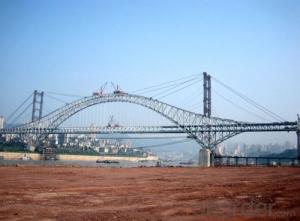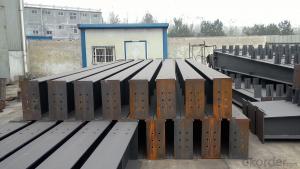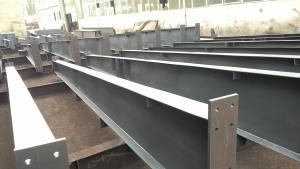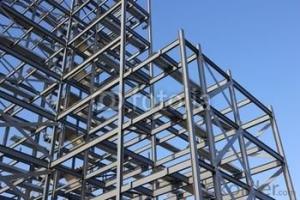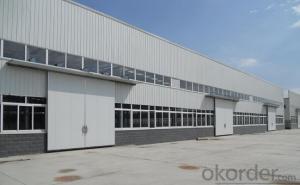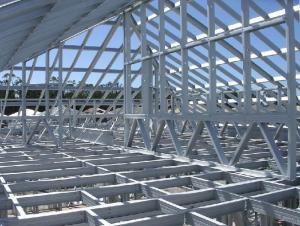Customized steel structure for bridge
- Loading Port:
- China Main Port
- Payment Terms:
- TT OR LC
- Min Order Qty:
- -
- Supply Capability:
- -
OKorder Service Pledge
OKorder Financial Service
You Might Also Like

Detailed Product Description
| Model Number | B |
| Material | Metal |
| Drawing for design | According to your requirement.We can quote according to your drawing. |
| Surface Treatment | Hot galvanized,painted,powder coated |
Packing Details
| a)Steel strip. |
| b)According to the customers' requirement |
Payments and Shipping Terms
| MOQ | 25 Ton |
| Supply Ability | 100 ton/Month |
| Payment Term | a)L/C b)T/T |
| FOB Shanghai Price | USD1000-1200/Ton |
Check Below for more imformation on placing an order
| 1. Inquiry-Professional quotation. |
| 2. Confirm the price, lead time, payment term etc. |
| 3. Our sales send the Proforma Invoice. |
| 4.Customer make the payment for deposit and send us Bank receipt. |
5.We will arrange the production & inform the estimated time. |
6. Middle Production:send photos to show the production line which you can see your products in . Confirm the estimated delivery time again. |
7. End Production:Mass production products photos will send to you for approval. You can also arrange the third party Inspection. |
8. Clients make payment for balance and we Ship the goods .Also can accept payment term-Balance against B/L Copy Or L/C payment Term. Inform the tracking number and check the status for clients. |
9. Order can be say “finish” when you receive the goods and satisfy with them . |
10. Feedback to us about Quality , Service, Market Feedback & Suggestion. And we will do better. |
- Q:How are steel structures designed for architectural flexibility?
- Steel structures are designed for architectural flexibility through their ability to be easily modified and adapted. The use of steel allows for a wide range of design possibilities, such as curved or cantilevered shapes, and the ability to span large distances without the need for additional support columns. This flexibility allows architects to create unique and innovative designs that can be easily modified to meet changing needs or preferences. Additionally, steel structures can be easily expanded or reconfigured, making them ideal for buildings that may need to accommodate future growth or changes in use.
- Q:How are steel structures designed for resisting chemical exposures?
- The resistance of steel structures to chemical exposures is achieved through a combination of material selection, the application of protective coatings, and proper maintenance practices. To begin with, the selection of suitable materials is crucial in designing steel structures to withstand chemical exposures. Specifically, steel types like stainless steel or corrosion-resistant alloys are specifically chosen for their ability to endure the corrosive effects of chemicals. These materials possess higher levels of chromium, nickel, or other elements that enhance their resistance to chemical reactions. Furthermore, protective coatings are employed to establish a barrier between steel structures and the chemicals they may encounter. These coatings can take the form of paint or specialized chemical-resistant coatings, acting as a shield that prevents direct contact between the chemicals and the steel, thus averting corrosion or structural damage. In addition, proper maintenance is paramount to ensure the long-term resistance of steel structures to chemical exposures. Regular inspections and maintenance activities, including cleaning, repainting, and repairing damaged coatings, are necessary to uphold the protective barrier. Additionally, swift removal of any chemical spills or leaks can prevent the accumulation of corrosive substances on the steel structure. In situations involving highly corrosive chemical environments, specific design considerations may be necessary. This may entail incorporating features such as enhanced ventilation, drainage systems, or protective barriers to minimize the exposure of steel to chemicals. In conclusion, the design of steel structures to resist chemical exposures encompasses a comprehensive approach that encompasses material selection, the application of protective coatings, and maintenance practices. By implementing these measures, steel structures can effectively withstand chemical attacks and maintain their structural integrity over time.
- Q:What are the design considerations for steel airports?
- When designing steel airports, there are several important considerations that need to be taken into account. These considerations include: 1. Structural Integrity: Steel airports must be designed to withstand various loads, including the weight of aircraft, passengers, and equipment. The structural design should ensure the integrity and stability of the entire facility, including the runways, taxiways, aprons, and terminal buildings. 2. Durability: Steel airports should be designed to withstand harsh environmental conditions, such as heavy rain, strong winds, and extreme temperatures. The materials used should be corrosion-resistant and able to withstand long-term wear and tear. 3. Flexibility and Expansion: Airports are complex facilities that are subject to changes in air traffic demand and technological advancements. The design should allow for flexibility and future expansion, accommodating changes in aircraft sizes, passenger volumes, and new technologies. This may include designing modular buildings that can be easily expanded or modified as needed. 4. Safety: Safety is a critical consideration in airport design. The layout should ensure efficient aircraft movements, minimize the risk of collisions, and provide clear emergency access routes. Additionally, fire safety, security measures, and adherence to international standards and regulations should be incorporated into the design. 5. Operational Efficiency: The layout and design of steel airports should be optimized for efficient operations, minimizing aircraft taxiing distances, reducing congestion, and improving passenger flow. This may involve careful planning of runway orientations, terminal layouts, and the integration of smart technologies for baggage handling, security checks, and passenger services. 6. Sustainability: In recent years, there has been an increasing focus on sustainability in airport design. Steel airports should incorporate energy-efficient systems and materials, such as solar panels, LED lighting, rainwater harvesting, and green spaces. The design should also consider the environmental impact, noise pollution reduction, and the use of recycled or locally sourced materials. 7. Aesthetics: While functionality and safety are paramount, the design of steel airports should also consider aesthetics. Airports are often the first impression visitors have of a city or country, and a well-designed airport can create a positive image. This may involve incorporating iconic architectural elements, creating open and welcoming spaces, and utilizing natural light to enhance the passenger experience. Overall, the design considerations for steel airports encompass a wide range of factors, including structural integrity, durability, flexibility, safety, operational efficiency, sustainability, and aesthetics. By carefully considering these aspects, designers can create airports that are not only functional and safe but also efficient, sustainable, and visually appealing.
- Q:What are the common design considerations for steel educational or institutional buildings?
- Some common design considerations for steel educational or institutional buildings include structural stability, flexibility for future expansion or reconfiguration, efficient use of space, durability, energy efficiency, and compliance with building codes and regulations. Additionally, considerations for the specific needs and functions of the educational or institutional facility, such as classrooms, laboratories, libraries, or administrative spaces, are also important. The design should prioritize the safety and well-being of occupants while providing a comfortable and conducive environment for learning or institutional activities.
- Q:How are steel structures designed for different environmental conditions?
- Steel structures are designed for different environmental conditions by considering factors such as wind loads, snow loads, earthquake resistance, and corrosion protection. Engineers use specific design codes and standards that take into account the specific environmental conditions of the location where the structure will be situated. This includes calculating the maximum expected loads and stresses the structure will experience and designing it to withstand these conditions safely. Additionally, measures are taken to prevent or minimize corrosion, such as using protective coatings or galvanizing the steel. Overall, the design process ensures that steel structures are robust and resilient in various environmental conditions.
- Q:What is the process of galvanizing steel structures?
- The process of galvanizing steel structures involves immersing the steel in a bath of molten zinc. This creates a protective coating on the surface of the steel, preventing corrosion and increasing its lifespan. The steel is first cleaned and prepped to remove any impurities, then it is dipped into the zinc bath or sprayed with zinc to ensure complete coverage. Once the coating is applied, the steel is allowed to cool and the galvanized structure is ready for use.
- Q:What is the role of steel in environmental and sustainable buildings?
- The significance of steel in environmental and sustainable buildings cannot be overstated. Its numerous benefits and properties play a crucial role in these types of structures. To begin with, steel is an incredibly durable and long-lasting material. This reduces the need for frequent maintenance and repairs, which in turn minimizes waste generation and the consumption of resources over time. Additionally, steel is 100% recyclable, making it an excellent choice for construction. When a steel building reaches the end of its life cycle, the steel can be easily recycled and repurposed. This reduces the demand for new steel production and minimizes the carbon footprint associated with manufacturing. Moreover, recycling steel requires significantly less energy compared to producing new steel, resulting in energy savings. Furthermore, steel is lightweight, allowing for more efficient transportation and reducing carbon emissions during construction. The use of steel frame systems also enables flexible and open designs that optimize space utilization and allow for future modifications or expansions without major structural changes or demolition. Steel is also highly resistant to fire, earthquakes, and extreme weather conditions, providing a safe and resilient structure. This durability reduces the need for reconstruction or repairs, thus minimizing the environmental impact caused by these activities. Additionally, steel can contribute to energy efficiency in buildings. It can be used in the construction of energy-efficient roofs, walls, and windows, which help reduce heat transfer and improve insulation. This leads to lower energy consumption and greenhouse gas emissions for heating and cooling purposes. In conclusion, the role of steel in environmental and sustainable buildings cannot be underestimated. Its durability, recyclability, lightweight nature, and energy-efficient properties make it an ideal material for constructing environmentally friendly and sustainable structures. By choosing steel, we can contribute to reducing waste generation, conserving resources, minimizing carbon emissions, and creating resilient and energy-efficient buildings.
- Q:How are steel structures used in the construction of theme parks and amusement centers?
- Steel structures are commonly used in the construction of theme parks and amusement centers due to their strength, durability, and versatility. They provide the necessary support for large-scale rides, roller coasters, and other attractions, ensuring the safety and stability of these structures. Steel is also ideal for creating intricate and unique architectural designs, allowing for the creation of visually impressive structures that enhance the overall experience for visitors. Moreover, steel's ability to withstand extreme weather conditions makes it a reliable choice for outdoor amusement parks.
- Q:How are steel structures designed to be resistant to impact and blast loads?
- Various measures can be taken to design steel structures that are highly resistant to impact and blast loads. Firstly, a thorough understanding of the expected impact or blast loads is incorporated into the design process. This involves analyzing potential sources of impact or blast, such as explosions, collisions, or falling objects, and determining the magnitude, direction, and duration of the loads. To enhance resistance against impact and blast loads, several design strategies are employed: 1. Material selection: Superior mechanical properties of high-strength steel alloys are chosen to ensure structural integrity under extreme loads. These materials possess excellent ductility, toughness, and fatigue resistance, making them less prone to deformation and failure. 2. Structural redundancy: Redundant members and connections are included in the design to distribute the impact or blast loads throughout the structure. This redundancy prevents localized failures and ensures the structure can still bear the loads even if certain elements are damaged. 3. Progressive collapse prevention: Steel structures are designed with alternate load paths, such as secondary beams and columns, to prevent progressive collapse. This redirects forces in the event of a local failure, ensuring the structure remains stable and capable of withstanding impact or blast loads. 4. Blast-resistant design details: Specific design details are implemented to enhance resistance against blast loads. These include minimizing the size and number of openings in the structure, using blast-resistant glazing systems, and incorporating sacrificial elements that absorb and dissipate blast energy. 5. Reinforced connections: Connections between structural members are crucial for withstanding impact and blast loads. Special attention is given to their design, including the use of high-strength bolts, welding techniques, and additional reinforcement, such as stiffeners or plates, to improve their resistance to dynamic loads. 6. Blast-resistant coatings: Applying blast-resistant coatings on structural elements can enhance their resistance to blast loads. These coatings are designed to absorb and dissipate energy, reducing transmitted forces and protecting the underlying steel from damage. 7. Dynamic analysis: Advanced computer simulations and finite element analysis techniques are utilized to evaluate the response of steel structures to impact and blast loads. These analyses help identify potential weaknesses, optimize the design, and ensure the structure can withstand the expected loads. By incorporating these design strategies, steel structures can achieve high resistance to impact and blast loads. This resistance is crucial for safeguarding buildings and infrastructure against potential threats, ensuring the safety and security of occupants and assets.
- Q:How are steel structures designed to be resistant to corrosion in acidic environments?
- Steel structures are designed to be resistant to corrosion in acidic environments through a combination of material selection, protective coatings, and proper maintenance. Firstly, the choice of the type of steel used in the structure plays a crucial role in its resistance to corrosion. Stainless steel, which contains chromium, nickel, and other elements, is highly resistant to corrosion in acidic environments. The addition of these alloying elements forms a passive layer on the surface of the steel, which acts as a barrier against corrosive agents. Secondly, protective coatings are applied to the surface of the steel to provide an additional layer of defense against corrosion. These coatings can be in the form of paint, epoxy, or galvanizing. Paints and epoxies act as a physical barrier between the steel and the acidic environment, preventing direct contact and reducing the risk of corrosion. Galvanizing, on the other hand, involves applying a layer of zinc to the steel surface, which acts as sacrificial protection. Zinc corrodes preferentially over steel, sacrificing itself to protect the underlying steel from corrosion. Lastly, proper maintenance is crucial in ensuring the long-term corrosion resistance of steel structures in acidic environments. Regular inspections and maintenance procedures should be implemented to identify and address any areas of damage or deterioration in the protective coatings. Any damaged or corroded areas should be promptly repaired or replaced to prevent further corrosion from occurring. In conclusion, steel structures are designed to be resistant to corrosion in acidic environments by utilizing corrosion-resistant steel alloys, applying protective coatings, and implementing proper maintenance practices. These measures work together to ensure the longevity and structural integrity of steel structures in hostile environments.
1. Manufacturer Overview |
|
|---|---|
| Location | |
| Year Established | |
| Annual Output Value | |
| Main Markets | |
| Company Certifications | |
2. Manufacturer Certificates |
|
|---|---|
| a) Certification Name | |
| Range | |
| Reference | |
| Validity Period | |
3. Manufacturer Capability |
|
|---|---|
| a)Trade Capacity | |
| Nearest Port | |
| Export Percentage | |
| No.of Employees in Trade Department | |
| Language Spoken: | |
| b)Factory Information | |
| Factory Size: | |
| No. of Production Lines | |
| Contract Manufacturing | |
| Product Price Range | |
Send your message to us
Customized steel structure for bridge
- Loading Port:
- China Main Port
- Payment Terms:
- TT OR LC
- Min Order Qty:
- -
- Supply Capability:
- -
OKorder Service Pledge
OKorder Financial Service
Similar products
New products
Hot products
Hot Searches
Related keywords
